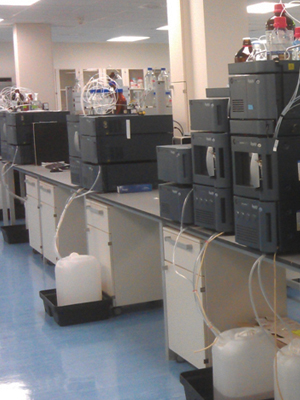The National Institute for Bioprocessing Research and Training (NIBRT) and Waters have released a first-of-its-kind database for glycan analysis using Waters ultraperformance liquid chromatography (UPLC).
 A bank of Waters ACQUITY UPLC Systems in NIBRT’s analytical laboratory.
A bank of Waters ACQUITY UPLC Systems in NIBRT’s analytical laboratory.
The GlycoBase 3+ Database designed by a research team of Professor Pauline Rudd from NIBRT is a database of chromatographic retention positions articulated in terms of glucose units for glycan structure sets that are related to a broad array of biotherapeutics. It is an ideal and powerful tool for manufacturers of biopharmaceuticals to verify the structure of different glycosylated proteins, helping them to achieve better control over production processes based on regulatory guidelines for producing safe and efficient biotherapeutics.
UPLC is capable of detecting the respective concentrations of every glycan structure in a pool. The Waters UPLC glycan analysis solution comprises an ACQUITY UPLC system featuring fluorescence detection and an ACQUITY UPLC BEH Glycan Separation Technology column to isolate the freed glycans of biotherapeutics as their 2-aminobenzamide derivatives. The solution offers a rapid, high-resolution, reproducible and powerful analysis when compared to a HPLC analysis.
The Waters UPLC glycan analysis solution combined with NIBRT's database is capable of readily assigning possible glycan structures such as sialylated, high-mannose, neutral and complex to every UPLC peak resembling a dextran hydrolysate ladder (GU values). The same bioinformatics platform can be used to assign Exo-glycosidase array digestion products in order to confirm the oligosaccharides’ monosaccharide connections and sequences. The technology can be customized to verify structures found in samples studied regularly or to detect unexpected or unidentified glycans. NIBRT and Waters will co-market the database globally.